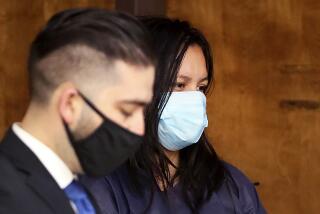Questions Remain as Mexican Drug Baron Is Buried
- Share via
MEXICO CITY — His death shrouded in as much mystery as his life, Mexican drug baron Amado Carrillo Fuentes was laid to rest Friday in the village of his birth, leaving behind a multibillion-dollar drug-smuggling network that has confounded and corrupted counter-narcotics authorities for nearly a decade.
As soldiers and police staked out Carrillo’s family ranch in Guamuchilito in the northern state of Sinaloa and villagers mourned the passing of their local philanthropist, authorities in the capital were still investigating how the 41-year-old drug lord died here a week ago after nine hours of plastic surgery, including liposuction.
It took Mexican prosecutors a week of DNA tests, fingerprint analyses and other comparisons to confirm that the body was that of Carrillo, who was rarely photographed and hardly ever seen in public during the years he dominated cocaine trafficking from South America through Mexico to the United States. All the tests were positive, prosecutors said after turning the body over to Carrillo’s family late Thursday.
Still, Mexican authorities acknowledged that they have yet to determine an official cause of death for the man known as the “Lord of the Skies,” a nickname earned through his pioneering use of jets to run hundreds of tons of cocaine into Mexico for transport to the United States.
“The attorney general is continuing the investigation . . . to determine the cause of death,” said a 14-page document detailing the exhaustive federal investigation that led to the conclusive identification of Carrillo--a determination the U.S. Drug Enforcement Administration made Sunday.
Late Thursday, authorities opened the door to the possibility that Carrillo was killed. Deputy Atty. Gen. Mariano Herran Salvatti said detectives were trying to determine whether the cause of death was “professional incompetence” by Carrillo’s doctors “or deliberate homicide.”
Investigators said Carrillo checked into Santa Monica Hospital in Mexico City about 7:30 p.m. July 3 under the name Antonio Flores Montes. The following day, accompanied by three personal physicians and two armed bodyguards, Carrillo was in the operating room from 9:30 a.m. until 6 p.m.--”an aggressive and high-risk surgery . . . to radically change his physical appearance.”
“The last clinical report was made between 10:30 p.m. and 11:30 p.m. in Room 407, and no anomalies were reported,” investigators say. By 4 the next morning, July 5, Carrillo was dead.
Herran, Mexico’s top counter-narcotics official, said the three doctors and two bodyguards are considered suspects, adding that his investigators are interviewing hospital personnel in Mexico City and Carrillo’s associates in Sinaloa.
Briefing reporters Thursday night, Herran indicated that Carrillo apparently turned to plastic surgeons because U.S. and Mexican federal investigators were turning up the heat on his organization.
Providing details for the first time of investigations into Carrillo, Herran said the drug baron and his Juarez cartel, which is based in the Mexican border town of that name opposite El Paso, had been paying off judges and senior police commanders up until his death.
In addition to allegedly corrupting Mexico’s former anti-drug czar, Gen. Jose de Jesus Gutierrez Rebollo, who is now in jail on charges of collaborating with Carrillo, the cartel bribed a judge to turn down prosecutors’ requests for search warrants and bribed federal police commanders in Carrillo’s home state to facilitate drug shipments as recently as last month.
Still, Herran said that in recent months his anti-drug agents have seized dozens of Carrillo’s properties throughout Mexico, frozen bank accounts containing up to $10 million each and narrowly missed capturing Carrillo himself at his sister’s January wedding because the drug kingpin was warned off by an army major in his employ.
At the same family ranch where that wedding took place, family and friends gathered Friday for Carrillo’s funeral. They sang hymns beside the open casket containing Carrillo’s mangled body as police and army troops observed the arriving guests from a checkpoint a quarter-mile away.
Carrillo’s seven brothers and sisters attended, among them brother Vicente, 34, whom U.S. counter-narcotics investigators expect to inherit at least temporary control of the Juarez cartel, which Carrillo took over in 1993 after its previous leader was assassinated.
In the years that followed, Carrillo used diplomacy to broker sophisticated deals with Colombia’s Cali cartel and other South American cocaine producers, making his cartel almost equal to the Colombians’ in power and profit, according to U.S. and Mexican federal agents.
At the same time, Carrillo spread his largess around his home state, financing churches, public works projects and other local development--generosity that was rewarded by the hundreds who flocked to his silver coffin Friday to pay their last respects.
More to Read
Sign up for Essential California
The most important California stories and recommendations in your inbox every morning.
You may occasionally receive promotional content from the Los Angeles Times.













